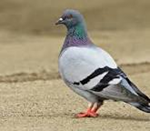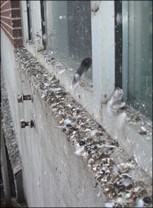Pigeon Deterrents
When people ask me what I do and I explain I’m in the bird control industry, they always respond with how interesting and pretty birds can be. I then explain to them how I only get to deal with a few ‘pest bird’ species and that the number one pest bird I’ve dealt with in my 20+ years in the industry is the Pigeon.

Unfortunately, the Victoria Crowned Pigeon pictured above isn’t even a species I’ve seen in my life. Though I do find common pigeons interesting, and all animals can be pretty in their own way.
However, by the time I get involved it is usually at the point where they have made a disgusting and dangerous mess and have caused thousands in damage and loss. I’d like to help people to solve their bird problems by deterring pigeons before it gets to that level.
So, in this blog, I will focus on one or two specific pigeon deterrents in each episode. I want to be fair on what has worked and what has not worked in my experience. But, before I can start on the specific pigeon or pest bird deterrents, I should share some basic facts, habits and biology in this first blog.
How to Deter Pigeons

The common pigeon (Columba livia) that thrives throughout the United States and all continents except Antarctica. Feral pigeons developed from the European rock dove and were introduced into this country as a domesticated bird. When these birds’ escaped captivity, they formed feral populations, creating a pigeon problem.
Features of the Common Pigeon
Pigeons have short, muscular bodies. With a height of 12 to 13.5 inches with weight of 10 to 13oz. The color of their feathers vary but is usually gray, with green, blue and purple glitters. They have short, yellow beaks with a slight curve. Today, the pigeon is probably the most serious bird pest associated with human habitations.
Pigeons are likely most known for their feasting habits—pigeons will happily eat just about anything they can find, from seeds and grains to garbage- which is why they thrive so well in human populated areas. Pigeons are commonly found around farmyards, grain elevators, feed mills, parks, city buildings, bridges and other areas that provide roosting, loafing and nesting sites and nearby food sources. They are also a common sight around commercial buildings and food production facilities.
Dangers of Pigeon Droppings

Pigeons and their bird droppings have been implicated in the transmission of diseases such as pigeon ornithosis, encephalitis and salmonella food poisoning. However, disease outbreaks that are directly attributed to pigeon flocks are rare.
Pigeon manure, if allowed to accumulate, can harbor the causal agent of histoplasmosis, a systemic fungus disease that affects the human respiratory tract. In severe cases, histoplasmosis can be fatal.
A Threat to Human Safety
The external parasites of pigeons include various species of mites, fleas, ticks and bugs. In addition to being a threat to human health, pigeons can be a threat to human safety, particularly around airports, where pigeon flocks have collided with aircraft, causing human fatalities. And, in slip and fall accidents as their droppings are greasy and can be very slippery.
Economic Impact of Pest Pigeons
There are 400 million pigeons in the world. In the USA alone, the negative economic impact is in the tens of millions of property damage, product damage, lost time clean-up of droppings and injury to people, The cost of mitigation and pigeon deterrents by themselves reach into the tens of millions each year as well. And the population of pigeons is continuing to grow.
More on Pigeon Control, Bird Netting, and Bird Spikes to Come…
Some tactics to get rid of pigeons include pigeon control products meant to scare pigeons, act as bird repellent, or discourage the act of pigeons congregating. The best pigeon repellents act before pigeons land and have a chance to cover your home or business in unsightly and unhealthy pigeon poop. In the next episode, I will discuss bird spikes, their positives and negatives, their place in the control of pigeons, and their value as a pigeon deterrent.
-
Migratory Bird Issues SolvedBy flockf
-
Do Bird Deterrents Work?By flockf
-
Bird Abatement: A Humane and Effective Solution to Bird-Human ConflictsBy flockf
-
Cockatoo Problems Solved With Flock OffBy flockf
-
What is the Most Effective Bird Deterrent for Billboards?By flockf
-
Will Flock Off hurt your netting business? – VideoBy flockf
-
Mike & Peter Testimonial – VideoBy flockf
-
Bird Control Technology – VideoBy flockf
-
Hospital Installation – VideoBy flockf
-
Bird Deterrent Technology – VideoBy flockf